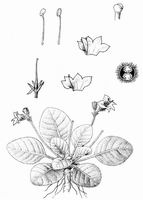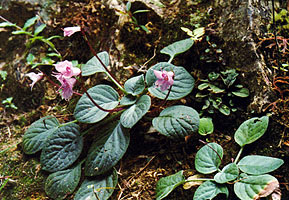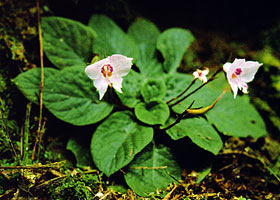
Ying T.S. et al., The endemic genera of seed plants of China, Fig. 109 (1993); with permission.
Full name and orig. publication: Dayaoshania W.T.Wang, Acta Phytotax. Sin. 21: 319 (Aug. 1983).
Etymology: Named for Dayaoshan, a mountain or montainous area in the Chinese province Guangxi, where the only species of the genus occurs.
Synonyms: -
Infrafamilial position: Didymocarpoid Gesneriaceae - "Advanced Asiatic and Malesian genera" (Weber 2004).
Description: Perennial rosette herbs with stout vertical rhizome or stem. Leaves alternate, petiolate, lamina broadly elliptic, orbicular-ovate or suborbicular, margin entire or inconspicuously blunt-serrulate, both surfaces white puberulous. Cymes 2-4, long-pedunculate, 1-2-flowered; bracteoles 2, opposite. Sepals free to base, narrowly triangular. Corolla white or pale purple, campanulate, tube short, widening, limb bilabiate, upper lip 2-lobed, lower lip 3-lobed or sometimes 2-lobed, lobes broadly triangular, acute. Stamens two (sometimes one); filaments inserted at corolla base; anthers dorsifixed, dark purple, longitudinally dehiscent; staminodes 2 or absent. Nectary annular. Ovary slender cylindrical, densely puberulous; style slender, sparsely puberulous; stigma bilobed. Capsule slender cylindrical, puberulous bivalved.
Chromosome number: Unknown.
Type and only species: Dayaoshania cotinifolia W.T.Wang
Species names (incl. publication and synonyms): See Skog, L.E. & J.K. Boggan. 2005: World checklist of Gesneriaceae: http://persoon.si.edu/Gesneriaceae/Checklist.
Distribution: S China (E Guangxi).
Ecology: Growing in forests on slopes, 860-1200m.
Selected references: Wang et al. in Wu & Raven (eds.), Fl. China 18: 291-292 (1998).
Bibliography: See Skog, L.E. & J.K. Boggan. 2005. Bibliography of the Gesneriaceae. 2nd edition: http://persoon.si.edu/Gesneriaceae/Bibliography.
Illustrations:
 |
Dayaoshania cotinifolia W.T.Wang, type
and only species.
Ying T.S. et al., The endemic genera of seed plants of China, Fig. 109 (1993); with permission. |

|

|
Dayaoshania cotinifolia W.T.Wang, type and only species. Li Z.Y & Wang Y.Z., Plants of Gesneriaceae in China, Figs. 1.93 and 1.94 (2004); with permission. |
last modified: 2007-07-13